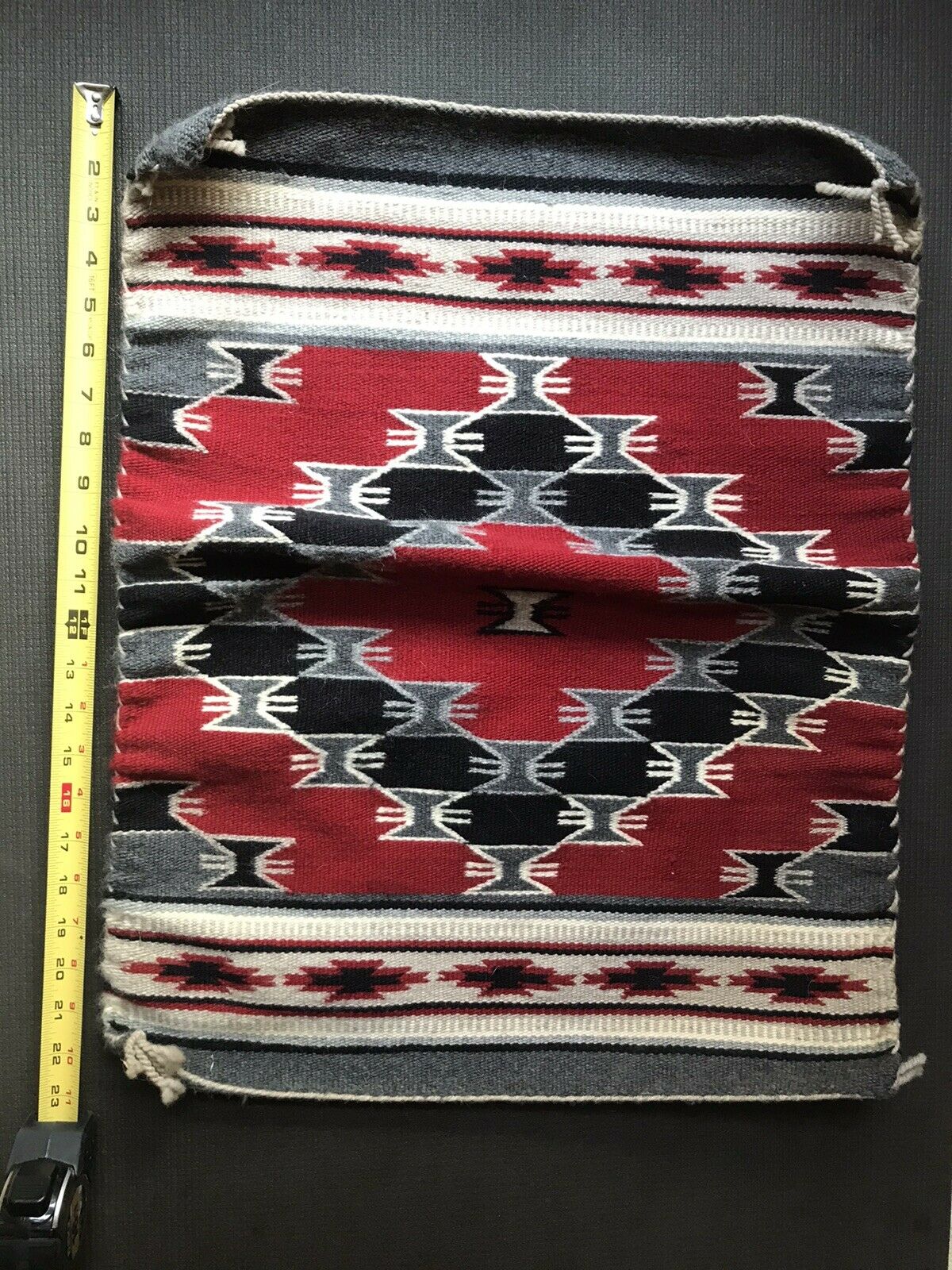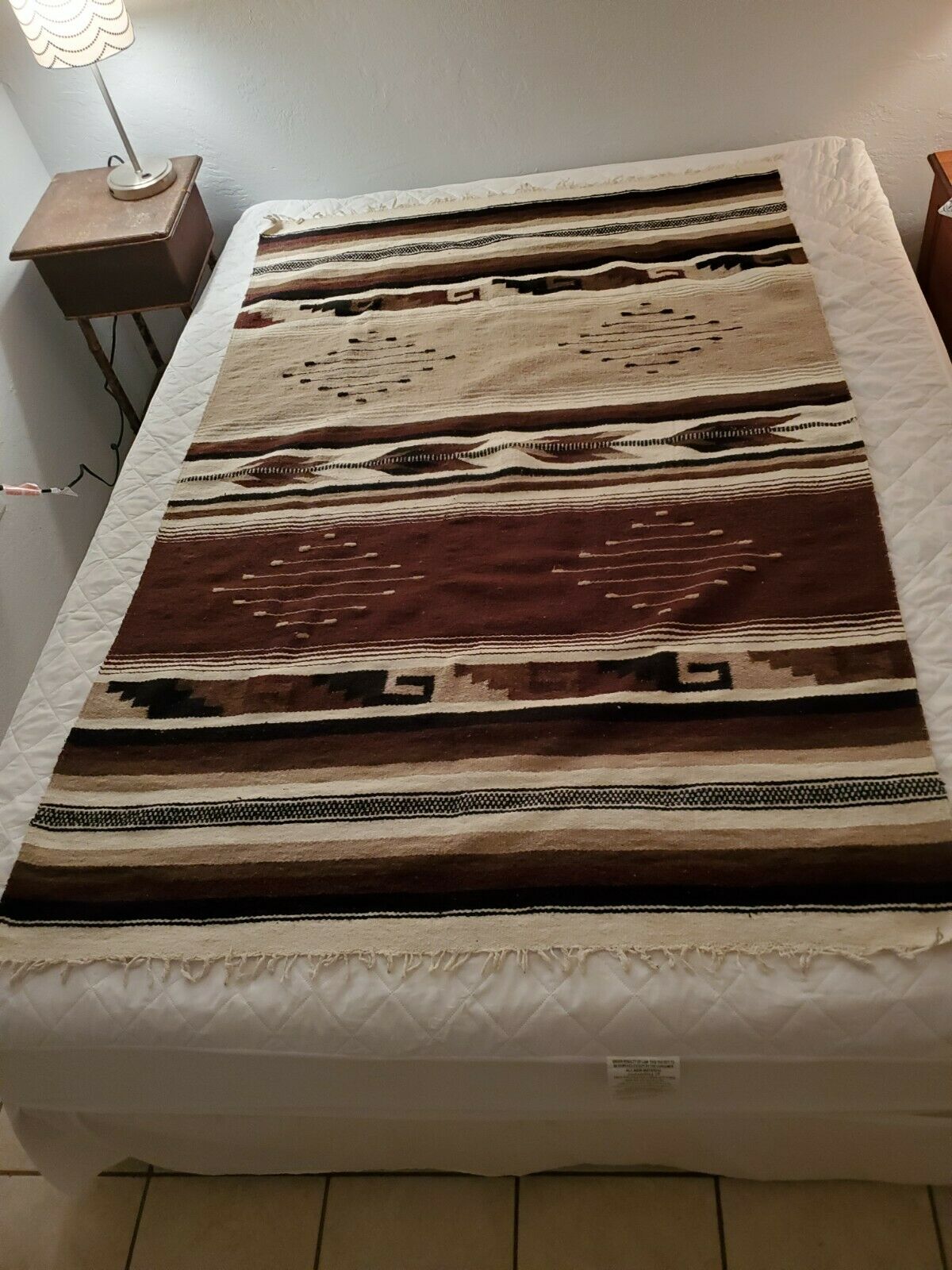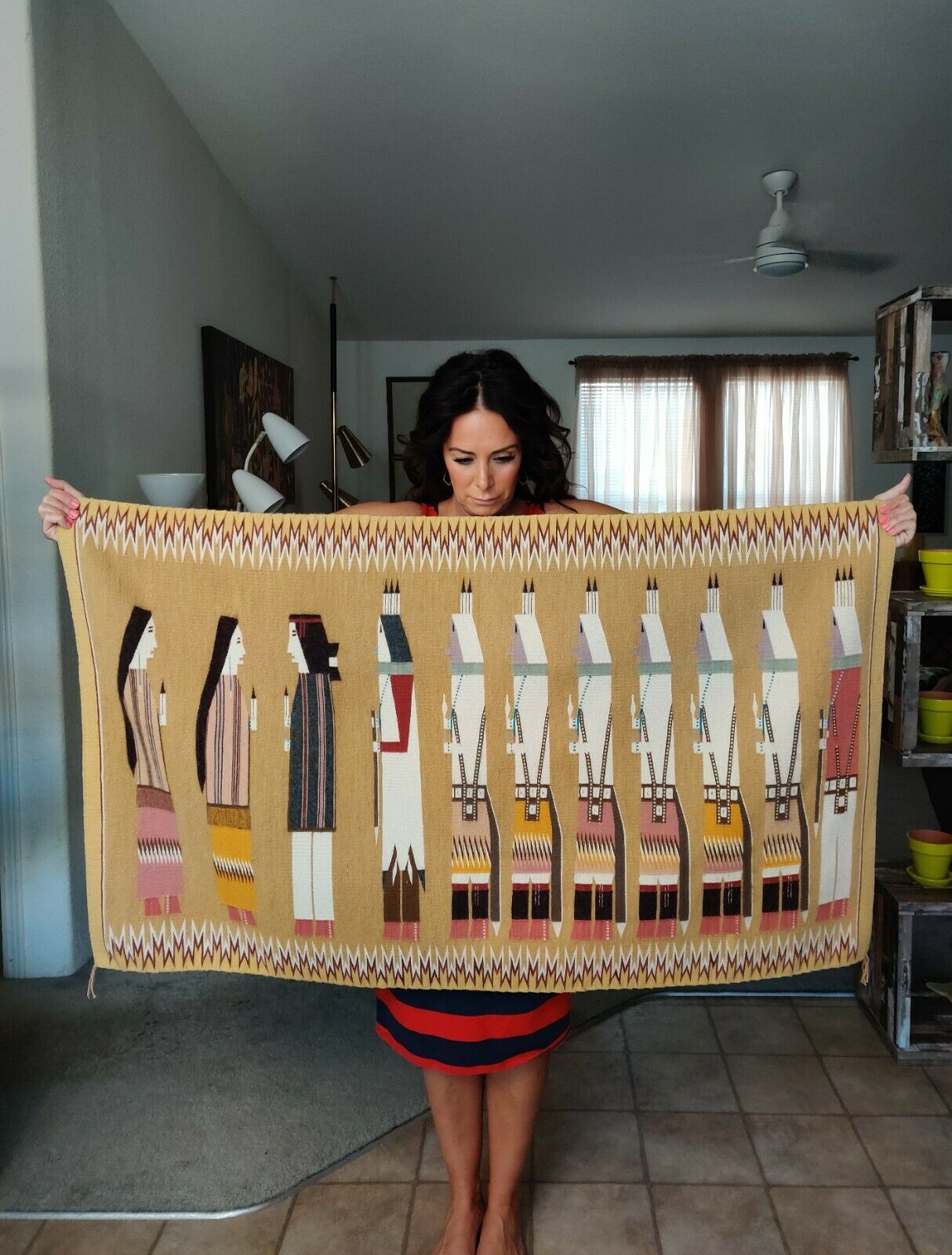-40%
VINTAGE Hand Woven Navajo Chinle Wool Rug 2.25 Feet by 2.8 Feet Ca 1950
$ 416.59
- Description
- Size Guide
Description
VINTAGE Hand Woven Navajo Chinle Wool Rug 2.25 Feet by 2.8 Feet Ca 1950VINTAGE Hand Woven Navajo Chinle Wool Rug 2.25 Feet by 2.8 Feet Ca 1950
Interested in more than one item? Email us for a package price on the ones you are interested in!
I buy and sell Native American Artifacts as a hobby both on and off the reservation and it's been an honor to have learned as much as I have and meet members of the Indian Nations that live near me.
For an old rug of this Quality & Size this IS one of the best Buys on Ebay or anywhere Today....
These Rugs Are an Excellent Investment and do Appreciate in Value.
This Vintage was recently acquired in a trade and is a nice size for a wall display, if you don't have much room!
Vintage Navajo Chinle Wool Rug
This Vintage Navajo Chinle Wool Rug was taken in trade recently and features the classic, banded pattern with squash blossom stars.
Woven in a restrained palette of colors, this traditional textile by an unknown weaver used natural and dyed yarns.
Handwoven with about 38 wefts to the inch, it's 27" by 33-1/2".
Circa 1950's, it's in very good, used condition.
This Vintage Navajo Chinle Wool Rug is exceptional, Native American art for your home or office!
We recently purchased a large collection of vintage and unused Native American artifacts including jewelry, rugs and pottery. It was part of the estate of a Navajo woman who was a missionary that worked with Native Americans in Four Corners - the area of the American southwest where four states meet- New Mexico, Arizona, Utah and Colorado. As a single parent, she raised 5 daughters and a son while also providing food, shelter, and clothing to less fortunate people that needed assistance. Often she was thanked for her help by gifts of Native American items.
Before the turn of the century, the Navajo switched from making traditional Native American blankets to weaving thick, brilliantly colored rugs with hand-spun wool. This dramatic shift featured “eye dazzling” geometric shapes and color palettes never before seen in such a medium, giving birth to what is now known as the Eye Dazzler rug.
Spirit Influences Freedom
Though not always considered the epicenter of the Navajo culture, Eye Dazzlers offer weavers the chance to express their individual artistry, freedom and ceremonial musings. Thus inspire those who purchase them to be influenced by the weavers infusion of spirit into their designs, creating a common bond with the artist and collector.
Bold, Complex Designs
Believe it or not, there is no word for “art” or “sacred” in the Navajo language (most likely because everything natural is artful and sacred to them), and yet, both words accurately describe both the form and function of the Eye Dazzler. In years’ past, the bright, tightly-woven yarns and intricate designs may have been predicated on the aesthetic preferences of traders; however, the Eye Dazzler of today embodies the early classic period so well that their intricate designs have been auctioned off for up to ,000!
The Navajo people are the descendants of hunter-gatherers who traveled southwards from Alaska and Northern Canada until they reached the area of the United States inhabited by the sedentary Pueblo Indians. According to legend, “Spider Man, one of the Navajo Holy People, taught the Navajos how to make a loom from sunshine, lightning and rain. Spider Woman taught them how to weave.” Thus, the loom and its trappings were constructed from the natural elements and the four compass points. Spirits are said to inhabit the sword and comb used in beating down the weft and there are taboos about what the weaver can and cannot do whilst handling these. As they weave, women chant particular ‘mantras’ from religious ceremonies to accompany them as they work.
In practice however, the Navajo probably began to weave sometime in the seventeenth century. They were taught and influenced by the Pueblo, who had a long tradition of weaving cotton clothing. The Navajo switched from weaving cotton to wool in about 1700 when sheep were introduced by the Spanish. Their high quality striped blankets were prized items and were worn by chiefs from other tribes. From 1863-68 the Navajo peoples were imprisoned by the Spanish at Bosque Redondo; separated from their sheep and sources of natural dyes, they were forced to rely on machine-spun yarns and commercial dyes.. Upon their release, reservation trading posts were set up under government supervision, mostly by men who had become interested in the commercial possibilities of Navajo work they had seen at Bosque Redondo and who were often responsible for introducing new and imported patterns.
Navajo Weaving Terminology
A basic familiarity with Terminology of Navajo weaving also is essential to the savvy collector as it is the only reliable way to authenticate Navajo rugs.
Navajo Rug designs differ on the Reservation according to the region and clan who weave them. Each rug is woven to include one small flaw in the final product in order that any evil spirits residing in the rug may have a way of escape.
Navajo Rugs woven by the grandmothers of the clan are held in great esteem and are in HIGH demand by the many tourists and collectors who buy each year.
Every month or so I visit the trading posts on the Navajo Reservation and talk to the traders and weavers there and get great information and advice from them.
Also I am going to offer you my advice from my personal experiences,
Become educated, by reading books, magazines, web sites, and other publications about Navajo rugs, and by speaking to knowledgeable rug dealers and traders.
The more you know about Navajo weaving, the more you will enjoy collecting them.
Warp
Warp strings are the vertical strings which serve as the foundation of the rug. Wool yarn is prefered because cotton warp strings may not tolerate rough use as a floor covering.
Weft (or Weave)
Weft threads are the horizontal threads that cover the warp threads, or the yarn that is woven over and under the warp and from side to side.
Wefts per inch are counted on both faces of a fabric. When the wefts are counted on one side, this number is doubled, as there is a corresponding weft on the other side. It can vary at different parts of the rug. The better the weaver the more consistent this will be throughout the rug.
Most Navajo rugs have approximately 30 wefts to the linear inch. A weft count of 50 or more per inch is a very high quality rug. A count of 80 or more qualifies a rug as a tapestry.
Selvage cords
Two or more yarns that twist about each other while interlacing with and reinforcing a fabric's edge. In Navajo textiles, two 3-ply selvage cords are usually twined together, forming a 2-strand edge. In Pueblo fabrics, three 2-ply cords usually form a 3-strand, twined selvage. There are also other variations.
Lazy line
A subtle diagonal break in the weave of many Navajo fabrics where a weaver has worked on adjacent sections of warps at different times; usually spaced apart no more than the length of the batten, lazy lines allow a weaver to weave a wide fabric without having to reach from side to side with each pass of the weft.
Weaver's Pathway (Sprit Line)
A small thin line that extends from the center design field across the border to the outside edge of some rugs; the line is frequently placed near a corner and made of the same color as the center field's background. Also called the spirit line. Associated with the belief of allowing the energy and spirit woven into a particular textile to be released in order for the weaver to have the energy and imagination to continue weaving other textiles.
HIGHLY COLLECTIBLE PIECE OF ART AND GOOD INVESTMENT!
These Rugs Are an Excellent Investment and do Appreciate in Value.
Compare your own financial investments over the past ten years to investments in pieces of Native American Indian and Mexican art and antiques!
We Include Special Shipping
Please be assured that this item will be well packed and arrive to you in excellent condition. We have years of experience in shipping this type of artwork. Please note also that our shipping charge includes postage, packaging, delivery confirmation and insurance.
If you want to add to your collection, take a look at our Handmade
Native-American-Dolls-Carvings
-
category where we have a wide selection of authentic pieces to choose from. Or just Click >>>
HERE
WHAT A GREAT GIFT IDEA FOR THE NATIVE AMERICAN
Katsina or Kachina Doll
COLLECTOR!
CERTIFIED AUTHENTIC NATIVE AMERICAN:
We understand the true value and nature of hand crafted Indian art. And, we recognize that it is important to know that the artist is truly a member of a Native American tribe. So, to ensure you that this is the real deal, a Certificate of Authenticity will be included with this item.
IMPORTANT - PLEASE READ:
ONLY PayPal is accepted.
Immediate Payment is required for all Buy it now or accepted Best offers.
SHIPPING:
Shipping by U.S. Postal Service First Class Mail & UPS with delivery confirmation.
Note:
We only ship once a week, after Payment has cleared. I do Combine Shipping just don't pay until you ask me for an invoice.
We are aware of your concerns in regards to the condition of your art work upon arrival. We have perfected our shipping, from years of experience in shipping this type of fine art, we can assure you, that your art work will arrive in excellent condition.
We suggest and prefer to use expedited shipping when sending fragile Native Crafts. We use safety and care every step of the way in packing and sending your Kachina to you.
International Buyers – Please Note:
Import duties, taxes and charges are not included in the item price or shipping charges. These charges are the buyer’s responsibility. Please check with your country’s customs office to determine what these additional costs will be prior to bidding/buying.
PLEASE READ ENTIRE PAGE BEFORE BIDDING AND FEEL FREE TO CONTACT US WITH QUESTIONS.
If you have any questions or issues with your order, please contact us--we'll resolve them for you.
We aim for five star service and want you to be happy - period.
International Buyers are willkommen, bienvenue, ????, welcome... :)
Statement of Authenticity:
We fell in love with Native American Artifacts many years ago and really appreciate the true craftsmanship that goes into the making of a piece of genuine Native American art! That is why we chose to partner up with some of the oldest and most reputable Trading Posts in the Southwest who deal directly with the Native American artisans to bring you a large selection of authentic Native American products. These artisans come from the Navajo, Zuni, Hopi and affiliate tribes on the reservations all of which our close to our home and office, so you can be assured that all our Native American products are authentic!
(Most of our items are One-of-a-Kind and subject to availability. We do sell on other venues as well as occasional trade shows and reserve the right to cancel this listing if sold prior to any bids or offers. We try to keep our listings up to date, but may occasionally miss one. If unavailable, we will email you and offer an alternate item or a refund if payment has been made. In some cases, we can have one custom made with a two week lead time.
Thanks for looking and be sure to check out my store for more selections of authentic Native American jewelry and artifacts! If you like our products, please add me to your FAVORITES list.
FEEDBACK:
is an essential part of what makes eBay a successful community. This is very important to
Both of us
. It lets us know that you have received your item and are happy with it. We use the eBay automated feedback option. As soon as we get feedback, it leaves you feedback in return.
PLEASE VISIT OUR STORE AND CONSIDER SUBSCRIBING TO OUR FREE NEWSLETTER FOR FUTURE LISTING UPDATES.
THANKS FOR LOOKING.
PLEASE CHECK OUR OTHER AUCTIONS
AND EBAY STORE..
We are always adding new items
!













